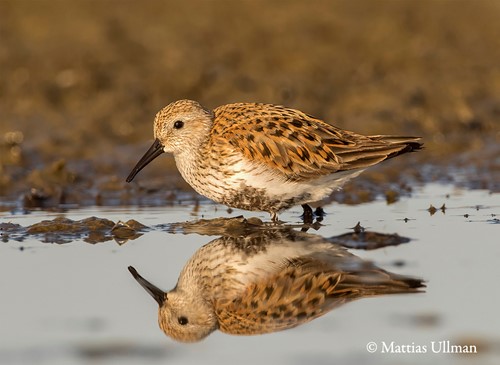Southern dunlin
Calidris alpina schinziiThe southern dunlin is a wader species about the size of a starling. Adult birds in breeding plumage are unmistakable, with their distinct black belly patch. Males are smaller and have shorter bills compared to females. The southern subspecies differs from the common dunlin in having a more diffuse belly patch, sometimes reduced to just a few black spots. Compared to the common dunlin, the southern dunlin is also smaller, slimmer, shorter-billed, and often less brightly colored.

Please note that this species is a project species that we work with on Öland, and it cannot be seen in the park.
Habitat and Nesting
The southern dunlin thrives in damp, grazed coastal meadows. It prefers areas with some grass tufts and patches of taller grass where chicks can hide. Nests are hidden on the ground, often placed near lapwing nests, as lapwings are effective at driving away predators like crows.
The southern dunlin typically lays four eggs, with both male and female sharing incubation duties for about three weeks. Once the chicks hatch, both parents care for them during the first week. Chicks hatch with nearly fully developed legs and bills and begin foraging within hours. After the first week, the female usually departs, leaving the male to care for the chicks for another 1–2 weeks. By 2–3 weeks of age, the chicks are self-sufficient and start learning to fly. At this stage, they venture into more open areas and forage along beaches, feeding on small animals washed ashore by the tide. They build up fat reserves for their long migration to Africa. If they survive the winter, they typically return to the same breeding area the following spring, around April.

Distribution in Sweden
Today, the southern dunlin is found only in southwestern Skåne and on Öland. In Skåne, fewer than 10 pairs remain (as of 2022), while Öland hosts approximately 60–70 pairs. As recently as the early 1900s, the southern dunlin was one of the most common breeding waders in parts of Skåne. By the mid-1980s, the population had declined significantly, though over 100 pairs still bred around Foteviken. Over the past 50 years, the population in Skåne has decreased by at least 95%, and likely by 99% over the last century.
Conservation Efforts
In 2022, Nordens Ark, in collaboration with BirdLife Sweden, launched a conservation project to save the southern dunlin, with support from the Swedish Postcode Lottery. You can read more about the project here.



